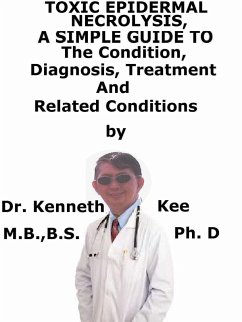>30% of the total body surface area SJS is a less serious presentation affecting mainly the lips, eyes and genital mucosa. People with 10-30% skin loss are categorized as "overlap". TEN is more often observed in people who have a specific genetic make-up (genotype) that leads to slow metabolizing of certain classes of drugs, or those who have HIV or are immune suppressed. There is the belief that an immune complex-mediated hypersensitivity reaction happens because of the presence of toxic drug metabolites which collect in the skin. This reaction leads to the damage of keratinocytes. Specifically, cytotoxic T lymphocytes produce keratinocyte damage and subsequent necrosis, mediated by granzyme B. Cytotoxic molecules such as FasL and granulysin have been indicated as causing the widespread keratinocyte apoptosis. More than 200 medicines have been linked with TEN, mostly: 1.Sulfonamides. 2.Ampicillin. 3.Quinolones 4.Cefalosporins. 5.Anticonvulsants - phenobarbital, phenytoin, carbamazepine, lamotrigine and valproate. 6.Allopurinol. Symptoms: There is a prodromal stage normally persisting 2-3 days with fever, symptoms the same as upper respiratory tract infection, conjunctivitis, pharyngitis, pruritus, malaise, arthralgia and myalgia. Mucous membrane affliction happens early in 90% of cases and often goes before other symptoms The conjunctivae, buccal, nasal, pharyngeal, tracheobronchial, perineal, vaginal, urethral and anal mucosae may all be affected. Skin lesions first occur in the pre-sternal region and the face, palms, and soles of the feet. A gentle touch or rub can slough the skin off and it is very painful (Nikolsky's sign) Diagnosis: There is no specific laboratory test required to diagnose TEN. Rapid histological examination such as direct immunofluorescence analysis of a lesion skin biopsy is first in the diagnostic work-up of TEN, as it helps to exclude diseases similar to TEN Treatment The first step is to stop the medicine causing TEN. Following this, the treatment for TEN and SJS is mostly supportive care until the top layer of skin regenerates. Affected individuals are often sent to a burns or intensive care unit and treated as if they have suffered from very severe burns. 1.Fluid and electrolyte replacement 2.Infection control with antibiotics 3.Pain relief 4.Skin care such as the use of topical antiseptics and regular wound dressings 5.Special wound nursing care 6.Eye, mouth and lung care 7.Urinary catheterization 8.Oral hygiene Some cases have benefited from the use of immunoglobulins, immunosuppressive agents, systemic steroids or other biologic agents. Debridement of necrotic areas of skin may be needed. The exposed dermis needs protecting with skin grafting to prevent fluid and protein loss and infection. TABLE OF CONTENT Introduction Chapter 1 Toxic Epidermal Necrolysis Chapter 2 Causes Chapter 3 Symptoms...
Dieser Download kann aus rechtlichen Gründen nur mit Rechnungsadresse in A, B, CY, CZ, D, DK, EW, E, FIN, F, GR, H, IRL, I, LT, L, LR, M, NL, PL, P, R, S, SLO, SK ausgeliefert werden.


